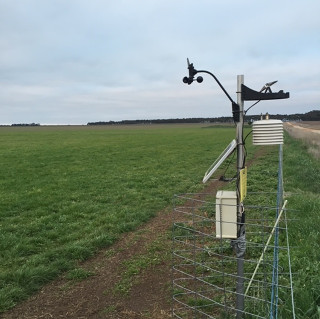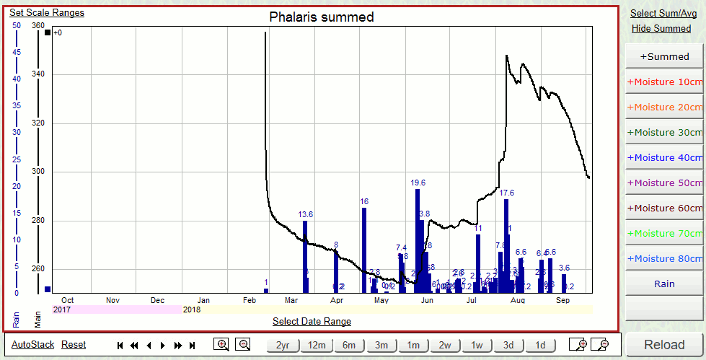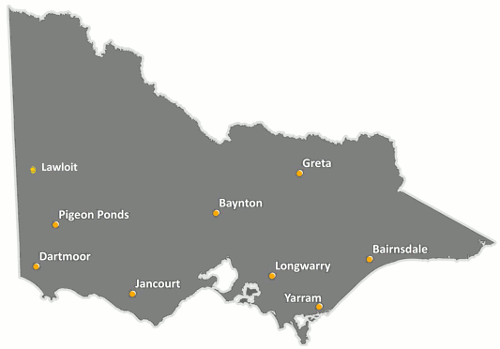Monitoring soil moisture and temperature in pastures

Agriculture Victoria has installed several soil moisture probes in a range of soil and pasture types across Victoria. Soil moisture probes have helped with making early decisions in the cropping industry for some time and may provide potential for optimising pasture production and management.
Pasture sites are located in South-West Victoria at Lawloit, Pigeon Ponds, Dartmoor and Jancourt; in Central Victoria at Baynton; in the North-East at Greta; and in Gippsland at Bairnsdale, Yarram and Longwarry (Figure 1).
The probes are capacitance enviropro probes. They are 80 centimetres long and have eight internal sensors to provide soil water content values and temperature every 10 centimetres. This will show water infiltration after rain events and use of water by plants as they grow dry matter (particularly in the absence of rain).
The probes are factory calibrated in a light soil medium but are currently not field calibrated to the soil type they have been installed into – which means the figures recorded do not represent millimetres of soil moisture.
Over time and a range of seasons, the data will show maximum and minimum soil moisture capacity, and a percentage of profile full at the time of interest. Different soil types at each site mean that sites cannot be directly compared with each other and are best assessed individually. Information on all sites is useful to show relative movement and use of moisture down the profile for the soil types and plant species at the site. Access the soil moisture monitoring sites.
How can these probes help in making decisions?
Croppers have indicated that they use the probes primarily for making early decisions on applying nitrogen and other inputs, based on estimated yield potentials. They also use the information for planting decisions on crop type, and harvest option (hay versus grain) during a dry spring.
Soil moisture can be a better forecaster of spring pasture growth than a seasonal weather forecast.
A pilot project over three pasture sites in South-West Victoria showed that soil moisture information was useful in the event of the looming dry spring in 2015 when it was used to estimate pasture growth that could be expected from applying urea. Other research has shown that, in late winter and early spring, soil moisture plays an increasingly important role in predicting spring pasture growth; it is a better forecaster of spring pasture growth than a seasonal weather forecast.
The earlier the prediction of spring growth (good or bad), the earlier decisions can be made on actions such as applying fertilisers, quitting stock or buying grain.
Soil moisture
The spatial soil moisture assessment from the Bureau of Meteorology, using the AWRA model, has clearly indicated where there has been spring potential – that is, moisture still in the root zone – compared with the dry areas north of the ranges and in East Gippsland. In these dry regions, either soil moisture levels failed to build up in the winter or any freely available soil moisture was depleted in early spring. Moisture probe data showed that the wet areas that built up soil moisture to field capacity in mid-August were showing signs of significant moisture depletion in September (at Baynton and Dartmoor).
The moisture probes installed in soil that was at, or close to, wilting point conditions during autumn will show plant moisture use this spring and give an estimate of the period for which the pasture will be productively growing. This will provide an earlier predictor of the length of the season in dryland areas than we have been able to estimate in the past.
Soil type (moisture holding ability) and the type of pasture growing with spring rainfall determine the length of the growing season. Information on the wilting point and field capacity in the space of six months will be valuable reference points in the future. We will learn more about the ability of plant root systems to extract deep soil moisture to enable plants to continue to grow into late spring.

As an example, the graph shows the summed (summed across each 10cm depth to 80cm) soil moisture data in the phalaris pasture at Greta to the end of October in 2018. The bars show rainfall, and the line clearly shows when soil moisture peaked (to 50cm depth) in mid-August; it has rapidly depleted since as a result of low rainfall and moisture use by the pasture. Most of the soil moisture built up in early August was depleted in a month.
Soil temperature
Soil temperature, like moisture and fertility, plays a major role in controlling plant growth. Plant species have different temperature requirements. The soil temperature at sites can be monitored to show when it will start to limit plant growth and legume nitrification. White clovers (and presumably sub-clover) will stop fixing much nitrogen below about 9°C, which can provide some opportunities for responses to urea.
Research in Tasmania indicated that perennial ryegrass will grow down to about 5°C and annual ryegrass to as low as 2°C. Australian phalaris also grows down to about 5°C, and a 'guesstimate' for more winter-active cultivars is 1.5–2°C lower.
Soil temperature, like moisture and fertility, plays a major role in controlling plant growth.
Monitoring soil temperature and moisture over winter/early spring can provide some clues about opportunities for applying urea and/or giberellic acid to boost pasture growth, given that soil fertility is adequate. The Bairnsdale site had limited potential because of low soil moisture over winter, despite higher soil temperature than other sites.
Keep up to date
Interested in keeping up to date with soil moisture and temperature and accessing the data online from these sites? Express your interest in getting updates to Monitoring Soil Moisture in Pastures (produced at key times of the year) and for web access to the site data at all times or contact Jane Court at Jane.court@ecodev.vic.gov.au or 03 5430 4597.
